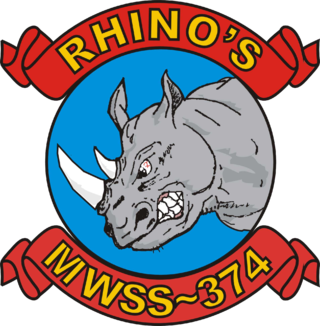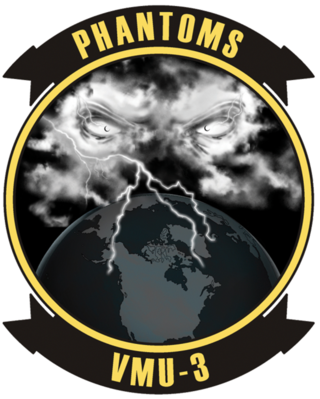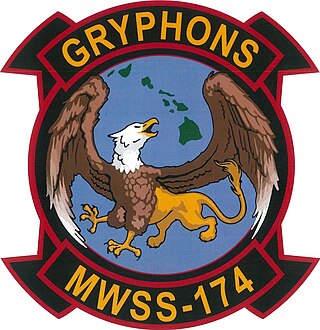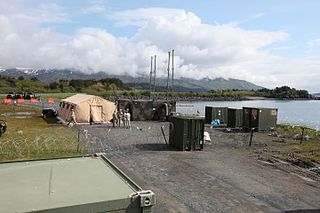
McEntire Joint National Guard Base or McEntire JNGB is a military airport located in Richland County, South Carolina, United States, 10 miles (16 km) west of the town of Eastover and approximately 15 miles southeast of the city of Columbia. It is owned by the U.S. Air Force affiliated with the South Carolina Air National Guard (SCANG).

Marine Aircraft Group 13 is a United States Marine Corps aviation unit based at Marine Corps Air Station Yuma that is currently composed of one McDonnell Douglas AV-8B Harrier II squadron, three Lockheed Martin F-35B Lightning II squadrons, an unmanned aerial vehicle squadron, a maintenance and logistics squadron, and a wing support squadron. The group falls under the command of the 3rd Marine Aircraft Wing and the I Marine Expeditionary Force.

Marine Heavy Helicopter Squadron 463 (HMH-463) was a United States Marine Corps helicopter squadron consisting of CH-53E Super Stallion transport helicopters. The squadron, also known as "Pegasus", was last based at Marine Corps Air Station Kaneohe Bay, Hawaii and fell under the command of Marine Aircraft Group 24 (MAG-24) and the 1st Marine Aircraft Wing. HMH-463 was decommissioned in April 2022 as part of the Commandant of the Marine Corps Force Design 2030 initiative.

Marine Wing Support Squadron 374 was an aviation ground support unit of the United States Marine Corps. They were based out of Marine Corps Air Ground Combat Center Twentynine Palms, California. The squadron was part of Marine Wing Support Group 37 and the 3rd Marine Aircraft Wing. MWSS-374 was officially deactivated, 31 March 2022, at Marine Corp Air Ground Combat Center,(MCAGCC) 29 Palms,Ca. during a Sunset Ceremony.

Marine Air Support Squadron 6 (MASS-6), is a reserve United States Marine Corps aviation command and control unit that provides the Direct Air Support Center (DASC) for the Marine Forces Reserve. Their headquarters is in Westover Air Reserve Base, Massachusetts and their Detachment Alpha is located at Marine Corps Air Station Miramar, California

Marine Air Control Squadron 1 (MACS-1) is a United States Marine Corps aviation command and control squadron. The squadron provides aerial surveillance, air traffic control, ground-controlled intercept, and aviation data-link connectivity for the I Marine Expeditionary Force. It was the first air warning squadron commissioned as part of the Marine Corps' new air warning program and is the second oldest aviation command and control unit in the Marine Corps. The squadron is based at Marine Corps Air Station Yuma and falls under Marine Air Control Group 38 and the 3rd Marine Aircraft Wing.

Marine Air Control Group 28 (MACG-28) is a United States Marine Corps aviation command and control unit based at Marine Corps Air Station Cherry Point that is currently composed of four command and control squadrons and a low altitude air defense battalion that provide the 2nd Marine Aircraft Wing with airspace coordination, air control, immediate air support, fires integration, air traffic control (ATC), radar surveillance, aviation combat element (ACE) communications support, and an integrated ACE command post in support of the II Marine Expeditionary Force.

Marine Air Control Squadron 4 (MACS-4) is a United States Marine Corps aviation command and control squadron that provides aerial surveillance, Ground-controlled interception, and air traffic control for the III Marine Expeditionary Force. Originally formed in World War II, the squadron's most notable combat operations occurred during the Vietnam War when it was the first unit to ever use the Marine Tactical Data System. They are currently based at Marine Corps Air Station Futenma and fall under the command of Marine Air Control Group 18 and the 1st Marine Aircraft Wing.

1st Marine Expeditionary Brigade is a unit in the I Marine Expeditionary Force and is the "middleweight" global crisis response force.

Marine Unmanned Aerial Vehicle Squadron 3 is an unmanned aerial vehicle (UAV) squadron in the United States Marine Corps that operates the MQ-9A Reaper that consists of approximately 200 Marines. They are based out of Marine Corps Base Hawaii, Kaneohe Bay, Hawaii and its primary mission is to provide aerial surveillance for the III Marine Expeditionary Force. The unit also provides Reconnaissance, Surveillance, and Target Acquisition (RSTA) to units participating in Mojave Viper, an exercise held several times a year in 29 Palms, CA. The squadron, nicknamed the Phantoms, was activated on 12 September 2008 and falls under the command of Marine Aircraft Group 24 and the 1st Marine Aircraft Wing.

Marine Wing Communications Squadron 38 (MWCS-38) is a United States Marine Corps communications squadron. The squadron provides expeditionary communications for the aviation combat element of the I Marine Expeditionary Force. They are based at Marine Corps Air Station Miramar, California, and fall under the command of Marine Air Control Group 38 and the 3rd Marine Aircraft Wing.

Marine Wing Support Squadron 174 (MWSS-174) is an aviation ground support unit of the United States Marine Corps.The squadron is based out of Marine Corps Air Station Kaneohe Bay, Hawaii and falls under the command of Marine Aircraft Group 24 and the 1st Marine Aircraft Wing.
Marine Tactical Data System, commonly known as MTDS, was a mobile, ground based, aviation command and control system developed by the United States Marine Corps for the execution of anti-air warfare in support of the Fleet Marine Force (FMF). It was the Marine Corps' first semi-automated system capable of collecting, processing, computing and displaying aircraft surveillance data while also sharing that information with other participating units via tactical data link. The system was developed in the late 1950s/early 1960s when it was recognized that due to the speed, range and complexity of fighter aircraft operations effective air control and air defense demanded enhanced situational awareness.

Marine Air Control Squadron 3 (MACS-3) was a former United States Marine Corps aviation command and control squadron. During its later years it also served as an operational test and evaluation squadron. Originally formed in World War II as Air Warning Squadron 12 (AWS-12), its original mission was to provide aerial surveillance and ground-controlled interception (GCI) for Marine Corps forces during amphibious operations. The squadron did not participate in combat operations during WWII however it did deploy and operate during the Korean War. In 1961, MACS-3 was transferred from the Fleet Marine Force to the administrative control of Air, Fleet Marine Forces Pacific in order to serve as the operational test and evaluation squadron for what was at the time, the largest research and development project in the Marine Corps - Marine Tactical Data System (MTDS). After MTDS testing was complete the Marine Corps recognized that it was not properly staffed to develop, test, and acquire new digital equipment. On 1 July 1970, MACS-3 was decommissioned and its structure and equipment were utilized to form Marine Corps Tactical Systems Support Activity (MCTSSA) at Marine Corps Base Camp Pendleton, California. Of note, MCTSSA does not carry MACS-3's lineage and honors.
Assault Air Warning Squadrons were United States Marine Corps aviation command and control units formed during World War II to provide early warning, aerial surveillance, and ground controlled interception during the early phases of amphibious landing. These squadrons were supposed to be fielded lightweight radars and control center gear in order to operate for a limited duration at the beginning of any operation until larger air warning squadrons came ashore. Four of these squadrons were commissioned during the war with one, AWS(AT)-5, taking part in the Battle of Saipan. All four squadrons were decommissioned on 10 November 1944 because the Marine Corps was unable to field the required mobile radars. The "first in" capability that the Assault Air Warning Squadrons were supposed to provide was transferred to the Early Warning Teams that were added to the tables of organization for the regular air warning squadrons.
The Marine Air Command and Control System (MACCS) is the aviation command and control agencies of the United States Marine Corps that provide the Aviation Combat Element (ACE) commander with the means to monitor, supervise, and influence aviation operations in support of the Marine Air-Ground Task Force. The command and control agencies of the MACCS are provided by the squadrons and battalions of the Marine Air Control Groups that are present within each Marine Air Wing. The capabilities resident within the MACCS allow the MAGTF commander to safely conduct aviation operations, facilitate timely maneuver and prosecution of fires and ultimately retain full control of their entire area of operations. MACCS agencies are also responsible for coordinating Marine Corps aviation operations with joint, multinational and civil aviation.
Marine Air Traffic Control Units (MATCU) were United States Marine Corps air traffic control (ATC) detachments that provided continuous, all-weather, radar and non-radar, approach, departure, enroute, and tower ATC services at both garrison Marine Corps Air Stations and tactical airfields when deployed. MATCUs possessed Tactical air navigation systems (TACAN) and Ground-controlled approach (GCA) equipment which assisted Marine Corps, joint and coalition aircraft in conducting landings during inclement weather. During the Vietnam War, numerous MATCUs served throughout the I Corps Tactical region of South Vietnam supporting the III Marine Amphibious Force. Beginning in the mid-1970s, the Marine Corps decided to consolidate regionally aligned MATCUs into Marine Air Traffic Control Squadrons. The last reserve MATCU was decommissioned in 1980.

Marine Air Traffic Control Squadron 18 (MATCS-18) was a United States Marine Corps aviation command and control squadron responsible for providing continuous, all-weather air traffic control services for the 1st Marine Aircraft Wing throughout the Pacific region. MATCS-18 was formed by consolidating four, regionally aligned Marine Air Traffic Control Units under one command to better integrate them with the Marine Air Command and Control System. The squadron was headquartered at Marine Corps Air Station Futenma, Okinawa, Japan and fell under the command of Marine Air Control Group 18. MATCS-18 was decommissioned in September 1994 and the air traffic control detachments were placed under the command of Marine Air Control Squadron 4.

The Tactical Air Operations Center (TAOC) is the principal air defense agency of the United States Marine Corps' Marine Air Ground Task Force (MAGTF). The TAOC provides real time aerial surveillance of assigned airspace, and its personnel identify, and control the intercept of hostile aircraft and missiles. It also directs and controls all Surface-to-air missiles in the MAGTF's area of operations.

















